The equipment of a laboratory in which students are to be trained for practical work in metallurgical chemistry presents many difficulties not encountered in the fitting up of a commercial or works laboratory. At an industrial plant the chemical work required usually demands the frequent repetition of a comparatively limited number of methods. In a steel-works laboratory, for instance, by far the larger part of the work consists in making determinations of the usual impurities found in iron and steel; at a smelter the great bulk of the work is confined to the analysis of ores, slags, mattes, and fuels, which involve the frequent application of perhaps not more than a dozen different methods. In a laboratory of this character, therefore, those operations most frequently applied may each have a certain section set apart and fitted permanently with such apparatus as best facilitates the carrying out of this one operation.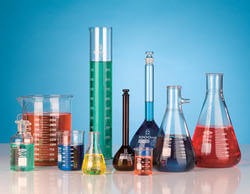
The work of a commercial or custom laboratory is perhaps more varied than that of a works laboratory, but the conditions are similar in these respects, that there is usually no great need for economy of space, and that a few skilled workmen are employed to carry the determinations through from beginning to end without interruption. On the other hand, the laboratory of a technical school should be planned on such a scale that a comparatively large number of students may work at the same time, and each desk should be equipped for general metallurgical analysis. In most institutions for technical education the student’s program is so arranged that his day is divided among several subjects in the course of study; only a few consecutive hours being devoted to one subject, or spent in one laboratory. Therefore, those appliances should be provided that render possible the safe continuation of such processes as precipitation and evaporation during the student’s absence; in other words, full provision should be made for maintaining constant temperatures for long periods. The fixed apparatus should be so assembled that the student may carry on at the same time as many operations (evaporation, filtration, titration, etc.), as possible at his own desk, and thus minimize the passing to and fro in the laboratory. The equipment of the school laboratory, however, should conform to that of the works laboratory in this particular, that all apparatus should be selected or
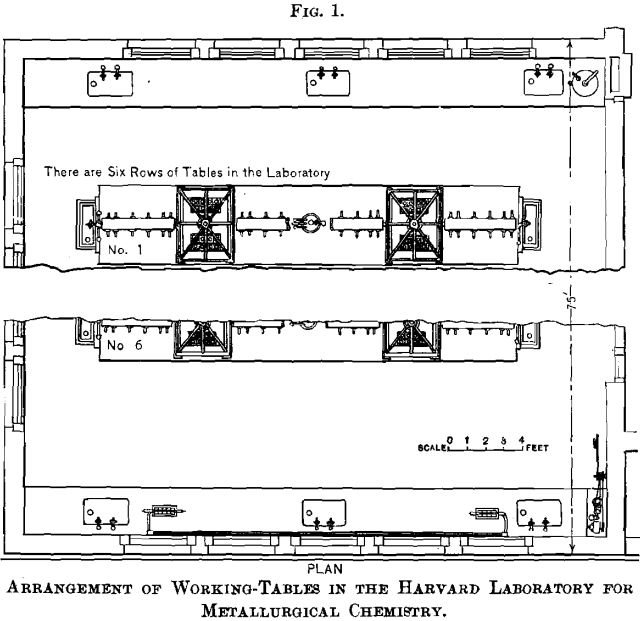
designed to attain the greatest accuracy and rapidity in analysis, in order that the skill in manipulation acquired in the technical school may be equal to that demanded of the practical analyst.
In the equipment of a laboratory for metallurgical chemistry in the Department of Mining and Metallurgy of Harvard University, in the year 1901, on the principles given above, a few innovations, in arrangement and appliances, were introduced, and, in consequence of the resultant advantages, they are taken as the basis of the present paper.
The general arrangement of the working-tables, shown in Figs. 1 and 2, is similar to that usually found in chemical laboratories, the unusual feature being the distribution of the hoods on the tables, in such a manner that each student has an individual hood-space at one side of his desk. In metallurgical analysis, a large part of the work of most determinations must be done under the hood; and evaporations, in order to be car-
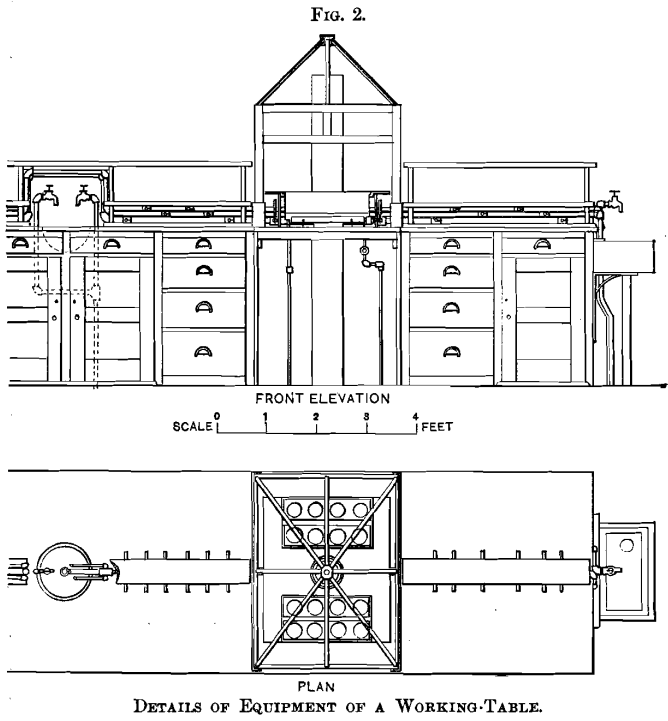
ried on with due rapidity and safety, should be constantly under the eye of the operator. This arrangement of hoods and their construction of glass enable the student to carry on simultaneously evaporation, or other hood-work not requiring constant manipulation, and such operations as filtration, washing of precipitates, titration, etc. Each desk is also provided with a sink, gas, compressed air and suction, so that there are few operations except weighing that cannot be carried through to completion without the necessity of leaving the desk.
Besides the advantages already noted in favor of the use of glass for the hoods there are the additional advantages that it is attacked by only a few chemicals, is easily cleaned, and does not obstruct the light. The sides of the hood should be supported on a base of the same material as the floor, so that the glass may not be brought too near the burners under the hot plates. The floor should be made sufficiently strong to support a moderately heavy weight. It should be constructed of noncombustible material, that will resist the action of chemicals and will not crack on heating. Slate has all the necessary qualities except that it is cracked by heat, and soapstone lacks the required strength. Portland cement reinforced, and provided with a tile-surface, would make perhaps the most satisfactory floor for a hood.
By an exhaust fan, the fumes are drawn through a pipe of glazed drain-tile, from near the top of the hood, down through the floor, and discharged from the building through a large main. The exhaust is sufficiently strong to dispense with the necessity for doors to the hoods.
The details of the equipment within the hood, shown in Figs. 3 and 4, consist of cast-iron hot plates, air baths, and hose- nipples for the attachment of Bunsen or other burners as required. The iron hot-plate has the form of the letter I, the open ends being filled by the air baths, the whole making a rectangular heating surface, having dimensions roughly proportional to those of the bottom of the hood, but somewhat smaller. The two pieces in which the hot plate is cast are held firmly together, by bolts, about the exhaust pipe in the center of the hood. The plate stands on iron legs, and in turn supports the air-baths on three sides by a flange. The two air- baths for one side of the hood are cast in one piece, as shown in section. This section also shows that the adjacent walls of the baths are cast 0.75 in. apart for the insertion of an asbestos board between them, which extends to the floor of the hood and prevents the heat from passing too freely from one bath to the other, and admitting of the easy control of the temperature in each bath independent of the other.
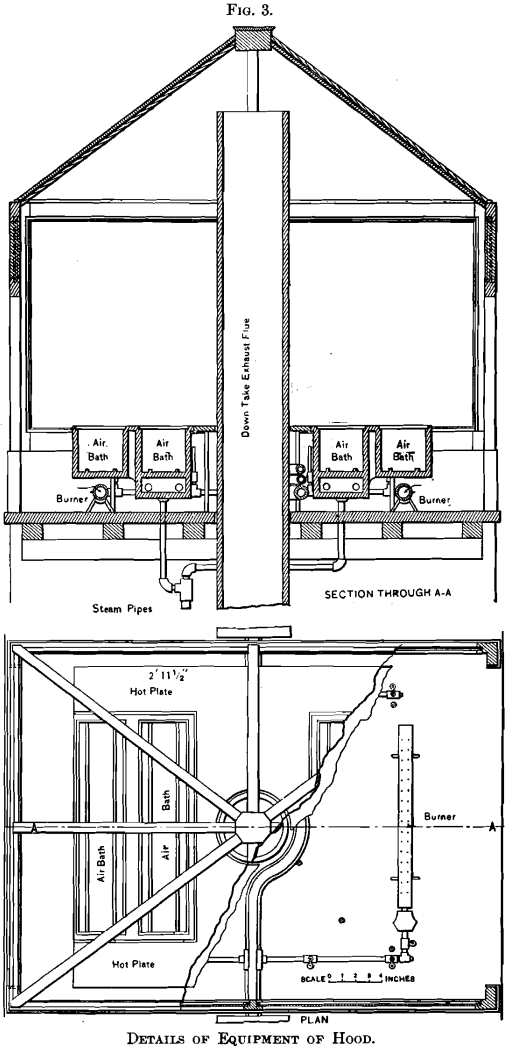
The burner by which the front bath is heated, shown in detail in Fig. 4, consists of an iron-pipe, or barrel, an air-mixer, and a neck connecting the two. The burner, which rests horizontally, has two rows of small perforations for the emission of the mixed air and gas. The gas enters the mixer through a small jet and draws the air into the burner with it. The air in the rear bath is kept at a constant temperature by steam deliv-
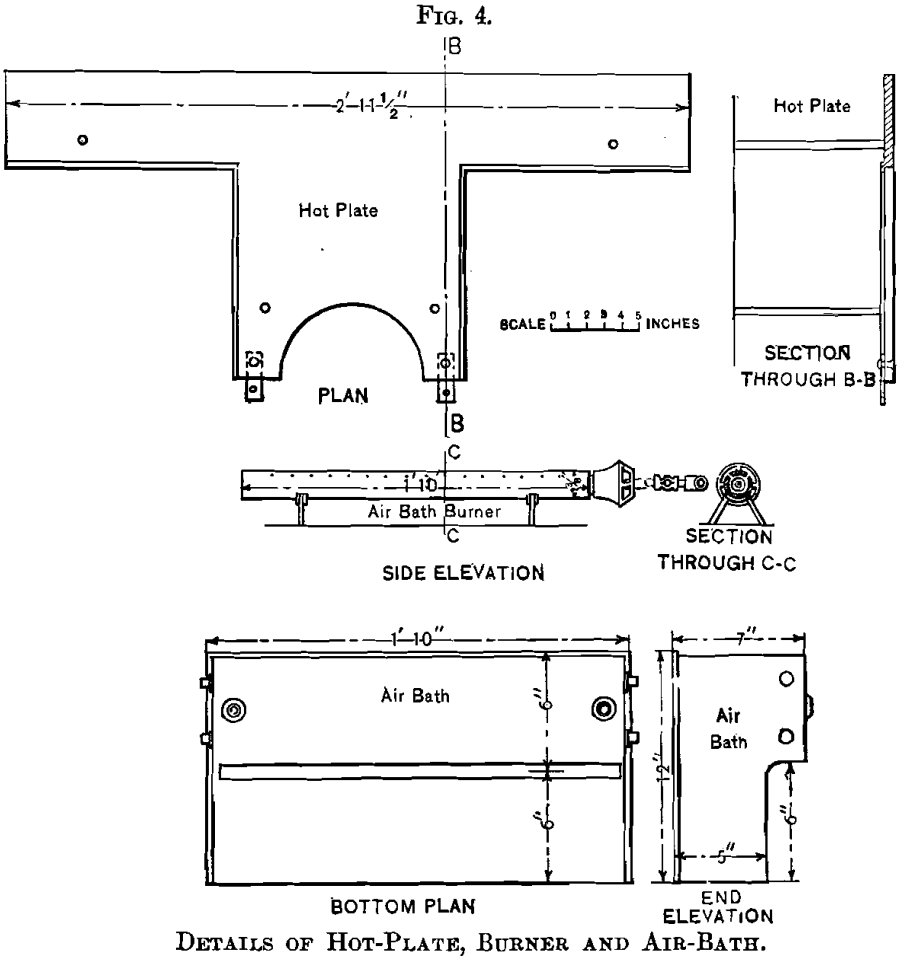
ered from the fire-room boiler to the steam-chest beneath the bath. The steam-chest is cast with the baths, and is connected by pipes with the boiler after the manner of a radiator. The heat is regulated by a steam-valve, the temperature in the bath depending upon the pressure in the boiler and the amount of steam admitted to the steam-chest. The baths having, therefore, only dry air, may be used for drying-ovens as well as for the other purposes to which steam and air baths are adapted.
All iron apparatus in the hoods is protected from the attack of chemicals by an occasional application of graphite in the form of stove polish.
Covers and rings for the baths are best made of porcelain, though strong asbestos board is a very satisfactory substitute. Burners for the hot plates may be such as are described above for the baths, or short Bunsen burners attached directly to the gas-pipe may be used. A Bunsen burner with tube less than half the usual length may be used without danger of snapping back, if the air is admitted through small openings to all sides of the gas jet.
There are two hose-nipples for compressed air and two for suction at each table. The compressed air and partial vacuum are each maintained at about 5 lb. per sq. in. by a small steam- pump in the fire-room. In addition to the usual apparatus used in connection with suction and compressed air to facilitate chemical work, there have been added mechanical stirrers of a very simple pattern operated by compressed air. The stirrer consists of a metal disc with small cups fixed to the periphery, after the manner of an anemometer, to which the jet of air is applied. The disc, fitted with a glass-rod spindle, is set up to rotate in a horizontal plane.
On the tables at each end of the laboratory are appliances for general use, including a condenser for distilled water, combustion furnaces, poles for electro-chemistry, a mechanically operated agate-mortar for grinding samples, and an agitator for chlorination and cyanide tests of gold-ores.
This laboratory at Harvard University has been used for two years, with very gratifying results. Not only has the quantity of work in the several courses been much increased, but the student’s interest in the work is also better maintained by the improved facilities for carrying through his determinations with despatch, thereby improving the quality of the work and enhancing its educational value.
